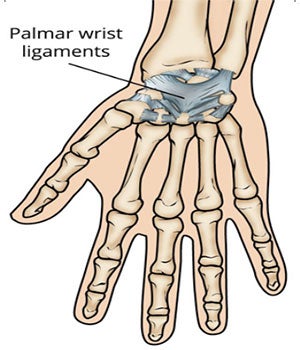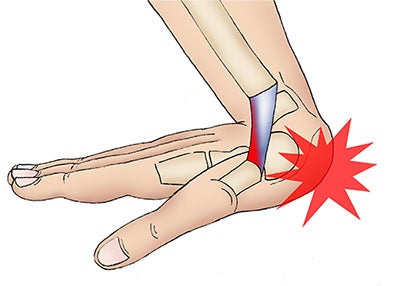
A sprained wrist occurs when the strong ligaments that support the wrist stretch beyond their limits or tear. This occurs when the wrist is bent or twisted forcefully. This can be caused by a fall onto an outstretched hand. Wrist sprains are common injuries. They can range from mild to severe, depending on how much damage there is to the ligaments.
Ligaments are strong, fibrous tissues that connect bones to other bones. The ligaments in the wrist help to keep the bones in proper position and stabilize the joint. Sprains can range from a stretch or tiny tear in the fibers that make up the ligament to a complete tear through the ligament or through its attachment to the bone.
What causes a sprained wrist?

Wrist sprains are caused most often by a fall onto an outstretched hand. This might happen during everyday activities, but frequently occurs during sports and outdoor recreation.
What are the symptoms of a sprained wrist?
A sprained wrist is painful. Other symptoms may include:
- Swelling
- Bruising
- Tenderness to touch
- A feeling of popping or tearing inside the wrist
- A feeling of warmth around the wrist
Even a wrist injury that seems mild with minimal swelling could have a torn ligament and require surgery to avoid long-term problems. Similarly, an unrecognized fracture can be mistaken for a mild or moderate sprain. If left untreated, the fracture may not heal properly and the patient could need surgery that might have been avoided with early, appropriate treatment. The most common example of this is an occult fracture of the scaphoid, one of the small bones in the wrist.
It is important for your doctor to evaluate even a mild wrist injury if it does not improve quickly. This is especially important if the injury causes persistent wrist pain. Proper diagnosis and treatment of wrist injuries is necessary to avoid long-term problems, including chronic pain, stiffness, and arthritis.
How is a sprained wrist diagnosed?
Your doctor will ask about any previous injuries to your hand or wrist. He or she will want to know how and when your current injury occurred and will ask you to describe your symptoms, including whether you have any numbness in your hand or pain in any other locations.
Your doctor will then carefully look at your wrist to see where it hurts and to check how it moves. Tenderness in certain areas may also be consistent with a broken bone. He or she will then examine your entire hand and arm to make sure you don’t have any other injuries.
What tests can be used to diagnose a sprained wrist?
Your doctor may order imaging tests to help confirm the diagnosis.
- X-rays. Although an x-ray will not show the ligaments themselves, it can suggest a ligament injury if the wrist bones do not line up correctly. An x-ray can also help your doctor rule out a broken bone in your wrist.
- Other tests. If more information is needed, a magnetic resonance imaging (MRI) scan, computerized tomography (CT) scan, or arthrogram may also be ordered. In an arthrogram, a special dye is injected into the wrist joint. This makes the joint and ligaments show up more clearly on an imaging study.
What are the different types of wrist sprains?
Sprains are graded, depending on the degree of injury to the ligaments:
- Grade 1 sprain (mild). The ligaments are stretched, but not torn.
- Grade 2 sprain (moderate). The ligaments are partially torn. This type of injury may involve some loss of function.
- Grade 3 sprain (severe). The ligament is completely torn or the ligament is pulled off of its attachment to bone. These are significant injuries that require medical or surgical care. If the ligament tears away from the bone, it may take a small chip of bone with it. This is called an avulsion fracture.
How is a sprained wrist treated at home?
Mild wrist sprains will usually improve with home treatment that includes the RICE protocol:
- Rest. Try not use your wrist for at least 48 hours.
- Ice. Apply ice immediately after the injury to keep the swelling down. Use cold packs for 20 minutes at a time, several times a day. Do not apply ice directly on the skin.
- Compression. Wear an elastic compression bandage to reduce swelling.
- Elevation. As often as possible, rest with your wrist raised up higher than your heart.
Additionally, nonsteroidal anti-inflammatory drugs (NSAIDs), such as aspirin or ibuprofen, can help reduce pain and swelling. If pain and swelling persist for more than 48 hours, however, see a doctor.
How is a sprained wrist treated without surgery?
Moderate sprains may need to be immobilized, prevented from moving flexibly, with a wrist splint for one week or more. Because immobilization may cause some stiffness in your wrist, your doctor may recommend some stretching exercises to help you regain full mobility.
How is a sprained wrist treated with surgery?
Severe sprains may require surgery to repair the fully torn ligament. Surgery involves reconnecting the ligament to the bone or using a tendon graft to reconstruct the injured ligament. Your doctor will talk with you about which option is best in your situation.
Surgery is followed by a period of rehabilitation that includes exercises to strengthen your wrist and restore range of motion. Although the ligament usually heals in 8 to 12 weeks, it can take from 6 to 12 months for a full recovery. The length of the recovery process and your outcomes will depend on the severity of the sprain.
How can you prevent a sprained wrist?
Because wrist sprains usually result from a fall, be careful when walking in wet or slippery conditions. Wrist sprains also occur during sports, such as skating, skateboarding, and skiing. Wearing wrist guards or protective tape when participating in these activities will help support your wrist and can prevent it from bending too far backward if you fall.
Departments and Programs Who Treat This Condition
Orthopedic Surgery
Pediatric Sports Medicine Clinic
Sports Medicine
 en
en 
 Français
Français Deutsch
Deutsch Italiano
Italiano Español
Español Tiếng Việt
Tiếng Việt Kreyol ayisyen
Kreyol ayisyen